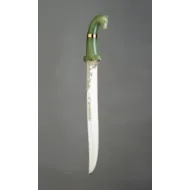An Indian Moghul Carved Light Green Jade Dagger Hilt
An Indian Moghul Carved Light Green Jade Dagger Hilt in the form of a Horses Head
with ruby eyes set in gold – a later English hallmarked silver blade converting its use to a paper knife
The jade hilt 18th Century
The silver blade hallmarked London 1890
Size : 49 cm long – 19 ¼ ins long
with ruby eyes set in gold – a later English hallmarked silver blade converting its use to a paper knife
The jade hilt 18th Century
The silver blade hallmarked London 1890
Size : 49 cm long – 19 ¼ ins long
At the end of the 16th century the proprietor of the Khotanese jade concession visited the Emperor Akbar’s court and introduced the new hard-stone to India enabling the Mughals to indulge a taste for jade already acquired by their Timurid ancestors in Central Asia.
The first serious Mughal patron was Akbar’s son Salim who as the Emporor Jahangir (1605-27) oversaw a development in which metal or ceramic forms copied in jade for the earlier Timurids gave way to designs based on more natural forms and decorative motifs. Naturalistically carved animal heads became a favourite subject for the decoration of Moghul weapon hilts.
Under the Emperor Shah Jahan (1628-58) the craft of jade carving reached it apogee sharing it design repertoire with architectural relief decoration such as that of the Taj Mahal. After this period there was no innovation in the design of jade objects, but a high standard of execution was maintained into the 18th century until the gradual collapse of court patronage following British military successes which led to a decline in the standards of taste and craftsmanship in these luxury goods.
The first serious Mughal patron was Akbar’s son Salim who as the Emporor Jahangir (1605-27) oversaw a development in which metal or ceramic forms copied in jade for the earlier Timurids gave way to designs based on more natural forms and decorative motifs. Naturalistically carved animal heads became a favourite subject for the decoration of Moghul weapon hilts.
Under the Emperor Shah Jahan (1628-58) the craft of jade carving reached it apogee sharing it design repertoire with architectural relief decoration such as that of the Taj Mahal. After this period there was no innovation in the design of jade objects, but a high standard of execution was maintained into the 18th century until the gradual collapse of court patronage following British military successes which led to a decline in the standards of taste and craftsmanship in these luxury goods.
An Indian Moghul Carved Light Green Jade Dagger Hilt

SOLD
